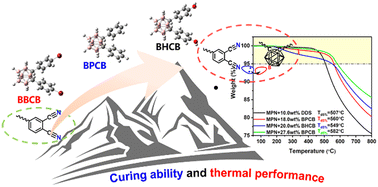A new approach to enhance the performance of phthalonitrile: study of carborane curing agents with dual functions†
Abstract
The current design of phthalonitrile resins has been faced with mutual constraints between heat resistance and functionality. Instead of retaining complex heat-resistant structures in the monomer to ensure thermal performance, this study proposes a new strategy to endow carborane cages with dual identities as curing sites and heat-resistant components by utilizing the σ–π double coordination properties of cyano groups. Through the NMR tracking of the soluble B-stage resin and the XPS test of the stage cured product, it is confirmed that the cyano group was bonded to the B–H bond on the carborane cage at the initial stage of curing. In the later stage of curing, carborane is evenly dispersed in the curing network during the formation of triazine and phthalocyanine rings and becomes an inorganic filler to enhance the temperature resistance of the resin system. By performing TGA on the cured product, the 5% decomposition temperature (Td5%) of the component containing the carborane curing agent was increased by 75 °C up to 582 °C under nitrogen atmosphere. The design of this new carborane curing agent with dual functions before and after curing provides a new idea for improving the comprehensive performance of the phthalonitrile resin system.



 Please wait while we load your content...
Please wait while we load your content...